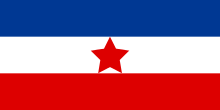Bihać Republic
| Republic of Bihać | ||||||||
| Bihaćka republika | ||||||||
| Liberated territory of Yugoslavia | ||||||||
| ||||||||
|
| ||||||||
 The Republic of Bihać within occupied Yugoslavia (pink). The borders are that of the World War II Axis partition of Yugoslavia, including collaborationist states. | ||||||||
| Capital | Bihać | |||||||
| Languages | Serbo-Croatian | |||||||
| Government | Socialist republic | |||||||
| Historical era | World War II | |||||||
| • | Established | 4 November 1942 | ||||||
| • | Disestablished | 29 January 1943 | ||||||
| ||||||||
| Today part of | | |||||||
The Bihać Republic was a short-lived republic that existed between November 1942 and January 1943 in a liberated area of Nazi-occupied Yugoslavia. It was established by the Partisan resistance movement following the liberation of Bihać. Bihać became its administrative center and the first session of the Anti-Fascist Council of the People's Liberation of Yugoslavia (AVNOJ) was held there on 26 November 1942.
Liberation of the territory
In the summer and fall of 1942 partisan forces improved largely its organization and tactics. Organized in mobile brigades, partisans were able to attack and overpower isolated Axis garrisons of battalion size and, in some cases, even stronger. Partisan units in western Bosnia and Croatia were largely reinforced with arrival of 6 brigades from eastern parts of Yugoslavia in summer 1942.
Bihać, the central town of the territory, was liberated on 4 November 1942 after two-day battle of 8 Krajina and Croatian brigades against 4th Ustaša Brigade and 12th Croatian Home Guard Regiment. Some towns were liberated earlier (Vojnić, Vrginmost, Korenica, Drvar, Glamoč, Bosanski Petrovac), and others were liberated in continuation of the Bihać operation: Bosanska Krupa on 5, Cazin on 6, and Slunj on 14 November. Some towns were liberated with independent attacks: Jajce on 26 November, Livno on 15 December, Tomislavgrad on 19 December 1942, and Teslić on 1 January 1943. Udbina and Bosansko Grahovo were under partisan pressure evacuated by ustaša and Italian units. Some towns were attacked unsuccessfully: Bosanski Novi and Dvor na Uni on 26–28 November, and Sanski Most on 10–22 December.
With this actions large territory, from Karlovac to the west, to Prozor to the east, was cleared of Axis forces. Partisans established control over some 250 km long and 50–70 km wide area.[1] Some towns were retaken by Axis forces in local attacks: (Jajce was reoccupied on 6 December, and Teslić on 8 January by Germans), but most of the territory was reoccupied in large offensives (Weiss I and Weiss II). Germans retook Bihać on 29 January, Drvar on 27 February, and Livno on 5 March 1943.
See also
Sources
- ↑ Tomasevich 1975, p. 232.
References
- Kapetanović, Hajro (ed.) (1965). BIHAĆKA REPUBLIKA, knjiga I - ZBORNIK ČLANAKA. Bihać: Muzeja Avnoja i Pounja.
- Kapetanović, Hajro (ed.) (1965). BIHAĆKA REPUBLIKA, knjiga II - ZBORNIK DOKUMENATA. Bihać: Muzeja Avnoja i Pounja.
- Popović, Jovo (1982). RATNE USPOMENE KOSTE NAĐA; BIHAĆKA REPUBLIKA. Zagreb: Spektar.
- Schmider, Klaus (2002). PARTISANENKRIEG IN JUGOSLAWIEN 1941-1944. Hamburg, Berlin, Bonn: Verlag E.S. Mittler & Sohn GmbH. ISBN 3-8132-0794-3.

